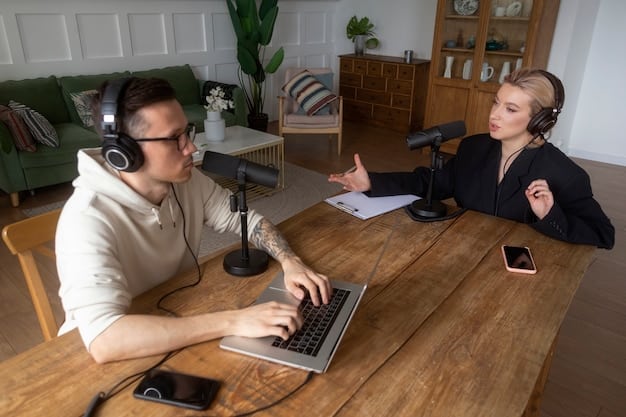Podcast Interviews Article podcast in bynowcast.com

Podcast interview storytelling transforms raw conversations into compelling narratives, leveraging structured techniques, active listening, and production prowess to captivate listeners and establish trust, effectively enhancing audience engagement and show authority.
In the dynamic world of audio content, merely conducting an interview isn’t enough; the true art lies in transforming that conversation into a captivating journey. Podcast interview storytelling: craft compelling narratives that engage listeners is the cornerstone of a truly successful podcast, elevating discussions from simple Q&A sessions to immersive experiences. It’s about weaving a thread through the dialogue, connecting seemingly disparate points, and culminating in an overarching message that resonates deeply with your audience.
The Essence of Narrative in Podcast Interviews
The power of storytelling in podcast interviews cannot be overstated. It’s what differentiates a forgettable chat from a memorable experience, holding the listener’s attention from start to finish. Narratives provide structure, emotional depth, and a human connection that raw information often lacks.
Every compelling interview, at its core, is a story waiting to be told. It begins with an introduction that sets the stage, establishes characters (the host and guest), and hints at the journey ahead. The middle unfolds with rising action, challenges, insights, and moments of discovery, all building towards a climax or a pivotal realization. Finally, a conclusion ties everything together, offering resolution or a clear takeaway. This narrative arc guides both the interviewer and the listener, preventing the conversation from meandering aimlessly.
Why Narrative Structure Matters
A well-defined narrative structure is crucial for several reasons. It helps listeners follow complex ideas, remember key points, and feel a sense of progression. Without it, even the most insightful interview can feel disjointed and overwhelming, causing listeners to tune out.
* Clarity and Cohesion: A narrative framework helps organize thoughts, ensuring the interview flows logically from one point to the next. This prevents the conversation from becoming a series of unrelated questions and answers.
* Engagement and Retention: Stories are inherently engaging. When listeners can follow a narrative, they are more likely to stay tuned for the entire episode and return for future ones. This significantly boosts listener retention and loyalty.
* Emotional Connection: Storytelling allows for the exploration of human experiences, struggles, and triumphs, fostering empathy and connection between the guest, host, and audience. Emotional resonance makes content more impactful and memorable.
* Memorability: People remember stories far more easily than isolated facts or figures. By embedding information within a narrative, you increase the likelihood that your audience will recall and act upon what they’ve learned.
Crafting Your Interview’s Narrative Arc
Before you even hit record, consider the story you want to tell. What is the central theme? What journey will your guest take the audience on? What is the core message or insight you want to convey by the end?
This pre-interview planning is vital. It involves identifying the most compelling aspects of your guest’s experience or expertise and thinking about how those elements can fit into a coherent arc. Sometimes, the narrative emerges organically during the conversation, but having a preliminary outline helps guide the discussion without stifling spontaneity.
Pre-Interview Prowess: Research and Preparation
The foundation of exceptional podcast interview storytelling is laid long before the recording begins. Thorough research and meticulous preparation are not just good practices; they are indispensable elements that enable a host to guide the conversation towards a compelling narrative.
Understanding your guest’s background, expertise, significant achievements, and even their public persona allows you to anticipate their responses, identify potential narrative threads, and formulate questions that delve deeper than surface-level inquiries. This preparation lends authenticity to the interview, as it demonstrates that the host values the guest’s time and insights.
Deep Dive Research
Begin by immersing yourself in your guest’s work. Read their books, listen to their previous interviews, scroll through their social media, and read articles or papers they have published. This extensive research is not just about avoiding redundant questions; it’s about uncovering the nuances of their journey, the turning points, and the underlying motivations that can form the backbone of your narrative.
* Identify Key Milestones: Look for moments of significant change, challenge, or success in their career or personal life. These often serve as excellent narrative anchors.
* Find Contrasting Viewpoints: Is there a common misconception about them or their work that you can explore? Contrasts can create compelling tension and provide a fresh perspective.
* Discover Personal Anecdotes: People connect with stories. Seek out moments or incidents that highlight their personality, resilience, or unique approach to their field. These personal touches add warmth and relatability.
Strategic Question Formulation
Armed with thorough research, you can move beyond generic questions. Your questions should be designed to elicit stories, not just facts. Think of open-ended questions that encourage detailed responses and reflection. Avoid “yes/no” questions, which tend to shut down conversation.
Consider asking “how” and “why” questions to explore processes and motivations. For example, instead of “Did you overcome challenges?”, ask, “Can you describe a specific challenge you faced and walk us through how you navigated it, step by step?” This phrasing invites a narrative response. Prepare follow-up questions that allow for exploration of tangents and unexpected insights, demonstrating your active engagement and willingness to follow the story where it leads.

The Art of Active Listening and Pivoting
Once the interview begins, preparation gives way to the dynamic dance of conversation. Here, the host’s ability to engage in active listening and deftly pivot the conversation becomes paramount to uncovering and shaping the narrative. Active listening is far more than just hearing words; it’s about discerning the underlying meaning, emotional tone, and potential story opportunities within a guest’s responses.
It means being fully present, paying attention to not only what is said but also how it is said. The subtle hesitations, shifts in tone, or moments of genuine passion often signal a rich vein of narrative waiting to be explored. This deep level of engagement allows the host to identify compelling threads and pursue them, even if they deviate from the pre-planned script.
Listening Beyond the Words
When a guest shares an anecdote, active listening helps you identify the universal themes within their personal experience—themes like resilience, innovation, failure, or triumph. These are the elements that resonate with a wider audience and contribute to a powerful narrative.
* Identify Emotional Cues: Notice areas where the guest shows strong emotion. These are often indicators of significant personal investment or pivotal moments in their story.
* Spot Narrative Gold: Listen for phrases that hint at a broader story, such as “It all started when…”, “Looking back, that was a turning point…”, or “What I didn’t realize then was…”
* Connect the Dots: As the conversation progresses, active listening enables you to connect seemingly disparate points, drawing parallels or highlighting contradictions that add depth to the narrative.
Strategic Pivoting and Follow-Ups
The magic often happens when a host knows when to pivot from a planned question to follow a more compelling narrative tangent that emerges organically. This requires confidence and a keen sense of what will be most engaging for the listener.
Knowing when to interject with a thoughtful follow-up, or when to let a guest elaborate, is a skill honed over time. Instead of rigidly sticking to a list of questions, consider the conversation a living entity. If a guest touches upon an intriguing point, be ready to dive deeper with a “Tell me more about that,” or “How did that specific event impact your thinking?” These follow-up questions are the chisels that reveal the sculpture of the story within the raw block of conversation.
Structuring the Interview for Impact
Beyond the live conversation, the true power of podcast interview storytelling often comes to fruition in the editing suite. However, effective structuring begins during the interview itself, as the host consciously guides the discussion to ensure that all the necessary “story beats” are captured. Thinking about the flow of the entire episode from the recording stage can streamline the post-production process and result in a more cohesive narrative.
A strong interview structure typically follows a classic narrative arc: beginning, middle, and end. The beginning hooks the listener, the middle develops the story and introduces complexities, and the end provides resolution or a clear call to action.
The Compelling Introduction
The opening moments of your podcast are critical. They serve as the podcast’s “first impression” and must immediately capture the listener’s attention. A good introduction does more than just state the guest’s name and credentials; it teases the central conflict, intriguing question, or unique perspective that the interview will explore.
* Hook the Listener: Start with a captivating anecdote, a surprising statistic, or a provocative question related to your guest’s story.
* Briefly Introduce the Guest: Provide just enough background to establish their credibility and relevance to the topic, without giving away the entire arc of their story.
* Set Expectations: Hint at the journey the listener is about to embark on, creating anticipation and encouraging them to stay tuned.
Building the Narrative Middle
The body of the interview is where the story unfolds. This is where you delve into the intricacies of your guest’s journey, their challenges, breakthroughs, and the lessons they’ve learned. Structure this section to build momentum, introducing new elements and perspectives progressively.
Consider organizing this section thematically or chronologically, depending on what best serves the story. For example, if your guest’s journey is linear, a chronological approach might highlight their evolution. If their expertise is diverse, thematic sections might make more sense. The goal is to move the narrative forward, exploring different facets of the guest’s experience or knowledge in a logical and engaging manner.
Crafting a Memorable Conclusion
The conclusion should provide a sense of closure, summarizing key takeaways, and reinforcing the core message of the conversation. It’s an opportunity to tie loose ends, offer final reflections, or inspire action. This is not merely a polite farewell; it is the final impression you leave on your audience.
A strong conclusion often includes a recap of the most impactful insights, an opportunity for the guest to share a final thought or call to action, and a gracious thank you. It should leave the listener feeling satisfied and perhaps even motivated to reflect further or explore the topic on their own.
Post-Production Magic: Editing for Narrative
Even the most well-conducted and structured interview can be significantly enhanced during the post-production phase. Editing is where raw audio transforms into a polished, compelling narrative. It’s an opportunity to tighten the dialogue, remove distractions, and artfully weave together the strongest moments to create a seamless listening experience.
This process involves more than just cutting out “ums” and “ahs.” It’s about shaping the pacing, adding sonic elements, and ensuring that the story flows logically and engagingly from one point to the next. A skilled editor acts as a second storyteller, enhancing the interviewer’s work by highlighting emotional beats, clarifying complex ideas, and maintaining the listener’s attention throughout the episode.
Tightening the Narrative
One of the primary goals of post-production is to eliminate anything that detracts from the narrative. This includes awkward pauses, repetitive phrases, unnecessary digressions, and any content that doesn’t serve the story’s purpose. Condensing segments of conversation can increase clarity and maintain momentum.
* Remove Dead Air: Cut out long silences or pauses that disrupt the flow.
* Trim Excess: Remove redundant information or sentences that don’t add value to the narrative.
* Smooth Transitions: Ensure that cuts between different segments or ideas are seamless, using subtle effects if necessary to bridge gaps.
Enhancing the Listening Experience
Beyond simply cutting audio, post-production offers a myriad of tools to improve the overall listening experience and enhance the emotional impact of the narrative. This includes careful attention to audio quality, pacing, and the judicious use of sound design.
Consider the pacing of the conversation. Are there moments where a slight pause could add dramatic effect? Or where a quick cut could emphasize a sudden realization? Sound design, such as background music or subtle sound effects, can also be strategically employed to underscore emotional moments, create atmosphere, or signal transitions between segments. However, this must be done sparingly and thoughtfully, as overuse can distract from the main narrative.
Mixing and Mastering
Finally, mixing and mastering are crucial for ensuring a high-quality finished product. This involves balancing audio levels between the interviewer and guest, reducing background noise, and applying equalization to ensure clear, consistent sound. A well-mixed and mastered episode sounds professional, making it a more pleasant and engaging experience for the listener, allowing them to fully immerse themselves in the story without audio distractions.
Leveraging Storytelling in Promotion and Outreach
The storytelling doesn’t end when the podcast episode is published; it extends into how you promote and share your content. Effective promotion hinges on extracting the most compelling narrative elements from your interview and using them to entice potential listeners. This means identifying the “hook,” the central conflict, or the most surprising insight from the episode and crafting promotional material around it.
Instead of merely announcing a new episode, think about what makes this specific story unique and impactful. What question does it answer? What challenge does it highlight? What transformation does it describe? By focusing on these narrative elements, you can create marketing copy that sparks curiosity and compels people to listen.
Crafting Compelling Show Notes
Your show notes are more than just a summary; they are a miniature story designed to encourage clicks. Use them to tease the most exciting parts of the interview, posing questions that the episode will answer or highlighting key moments of discovery. Instead of a chronological list of topics covered, consider framing your show notes as a narrative journey the listener is about to embark on.
* Highlight Key Moments: Include time stamps for particularly powerful or insightful segments, allowing listeners to jump directly to the good parts.
* Pose Intriguing Questions: Frame the content as a series of questions that the interview resolves, encouraging listeners to find the answers by tuning in.
* Use Strong Verbs and Descriptive Language: Make your show notes vivid and exciting, reflecting the energy of the conversation itself.
Social Media Snippets and Teasers
Social media platforms are ideal for sharing bite-sized narrative snippets. Extract short audio or video clips that capture a dramatic moment, a profound insight, or a humorous exchange. These snippets should be self-contained stories or powerful teasers that leave listeners wanting more.
Add compelling captions that explain the context or ask a thought-provoking question related to the clip. Use relevant hashtags to reach a wider audience interested in the topics discussed. Remember, each social media post is an opportunity to tell a mini-story that leads to the full narrative of your podcast episode.
Collaborating with Guests for Wider Reach
Your interview guest is often your best advocate. Provide them with shareable assets, such as pre-written social media posts, quote cards featuring their insights, and direct links to the episode. Encourage them to share the episode with their own audience, framing it in a way that highlights the story you collectively created.
When guests promote the episode, it reaches a new audience who might be specifically interested in their story or expertise, significantly expanding your reach and giving your compelling narrative the wider audience it deserves.
Measuring Engagement and Refining Storytelling Techniques
Understanding how your audience interacts with your narrative is crucial for continuous improvement. Data analytics and direct feedback provide invaluable insights into what resonates and what falls flat, allowing you to refine your storytelling techniques over time. It’s not enough to simply publish; actively learning from your audience’s behavior ensures your podcast evolves and strengthens its narrative appeal.
Podcast platforms offer a wealth of metrics, from total downloads to listener retention rates, average time spent listening, and even specific drop-off points within an episode. Analyzing these statistics can reveal patterns in audience engagement. For example, if listeners consistently drop off at a particular segment, it might indicate that the narrative faltered at that point, perhaps becoming too complex, too slow, or simply less compelling.
Analyzing Listener Data
Dive into your analytics dashboard. Pay close attention to:
* Audience Retention Graphs: These visual representations show where listeners are dropping off. A steep decline might suggest that a particular segment or transition isn’t working as intended, offering a pinpointed area for future narrative adjustment.
* Download Trends: Consistency in downloads for narrative-rich episodes compared to more straightforward interviews could indicate a preference for your storytelling approach.
* Geographic Data: Understanding where your audience is located can inform the cultural context of your storytelling, ensuring it resonates broadly.
Gathering Qualitative Feedback
Beyond numbers, direct listener feedback offers rich qualitative data. Encourage listeners to leave reviews, send emails, or participate in surveys. Pay attention to comments on social media or in podcast communities. Listen for specific mentions of what aspects of the narrative they found most engaging, insightful, or confusing.
Sometimes, the most valuable insights come from a casual comment about a guest’s specific story that truly resonated. This kind of feedback can validate your storytelling choices and highlight unexpected narrative threads that captivated your audience.
Iterative Improvement
The process of refining your storytelling is iterative. Each interview, each piece of data, and each listener comment provides a learning opportunity. Over time, you’ll develop a more acute sense of what kinds of stories your audience craves, what narrative structures are most effective, and how to consistently deliver compelling, engaging content.
This continuous feedback loop—listen, analyze, refine—ensures that your podcast interview storytelling remains fresh, relevant, and consistently captivating for your growing listener base. By understanding your audience’s journey with your content, you can master the art of narrative-driven interviews.
| Key Point | Brief Description |
|---|---|
| 📖 Narrative Core | Transforms interviews into cohesive stories with clear arcs, enhancing engagement and memorability. |
| 🔍 Pre-Interview Prep | Thorough research and strategic questions unveil deeper stories and guest insights. |
| 👂 Active Listening | Crucial for identifying narrative threads and pivoting to compelling conversation paths. |
| ✂️ Post-Production Polish | Editing refines the narrative, enhances audio quality, and optimizes pacing for impact. |
Frequently Asked Questions About Podcast Interview Storytelling
▼
Podcast interview storytelling is the art of transforming a standard interview into a compelling, cohesive narrative. It involves structuring the conversation with a clear beginning, middle, and end, highlighting emotional arcs, key insights, and personal anecdotes. This approach captivates listeners by making the content more relatable, memorable, and impactful, moving beyond a simple Q&A to an immersive auditory journey that resonates deeply with the audience.
▼
Narrative is crucial because it significantly boosts listener engagement and retention. Stories are inherently more memorable and emotionally resonant than dry facts. A clear narrative arc provides structure, making complex ideas easier to follow and digest. It creates a human connection between the guest, host, and audience, fostering empathy and making the content feel more personal and impactful, ultimately leading to a more loyal and invested listenership.
▼
Preparation is key. Begin with thorough research into your guest’s background, work, and public persona to identify potential narrative threads and pivotal moments. Formulate open-ended questions that encourage detailed, story-driven responses, focusing on “how” and “why.” Anticipate follow-up questions to delve deeper into compelling tangents, ensuring you can guide the conversation towards an unfolding story rather than just extracting information. This groundwork sets the stage for a rich narrative.
▼
Active listening is paramount. It allows the host to be fully present, discerning not just the words but also the emotional undertones and underlying meanings in a guest’s responses. This enables identification of “narrative gold”—those subtle cues or compelling details that can be explored further. By actively listening, hosts can strategically pivot from planned questions to follow more engaging, emergent stories, extracting richer content for the overall narrative.
▼
Post-production is where raw audio is polished into a compelling narrative. Editors can remove distractions, tighten dialogue, and smooth transitions for a seamless listening experience. They can also consciously shape the pacing, add subtle sound design (like music or effects) at key moments to heighten emotional impact, and ensure consistent audio quality through mixing and mastering. These techniques transform a recorded conversation into a meticulously crafted and engaging story.
Conclusion
Mastering podcast interview storytelling: craft compelling narratives that engage listeners is an ongoing journey that merges the art of conversation with strategic production. By embracing narrative structure, engaging in meticulous preparation, practicing active listening, and leveraging thoughtful post-production, podcasters can transform ordinary interviews into extraordinary auditory experiences. The result is content that not only informs but also resonates, builds connection, and cultivates a loyal, growing audience that eagerly awaits each new story you share.





